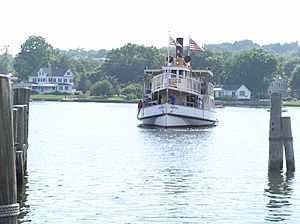Sabino (steamer) facts for kids
 |
|
| History | |
|---|---|
| Namesake | Abenaki sagamore Sabenoa |
| Owner | Mystic Seaport |
| Builder | W. Irving Adams |
| Launched | 1908 |
| Status | Museum ship |
| General characteristics | |
| Length | 57 ft (17 m) |
| Beam | 21 ft 11 in (6.68 m) |
| Draft | 6 ft 3 in (1.91 m) |
| Installed power | Paine compound two-cylinder steam engine |
| Speed | 8 knots (15 km/h; 9.2 mph) |
| Crew | 3 |
|
Sabino (steamer)
|
|
|
U.S. Historic district
Contributing property |
|
| Location | Mystic, Connecticut |
| Built | 1908 |
| Architect | H. Irving Adams |
| Part of | Mystic Bridge Historic District (ID79002671) |
| NRHP reference No. | 92001887 |
| Significant dates | |
| Added to NRHP | 5 October 1992 |
| Designated NHL | 5 October 1992 |
| Designated CP | August 31, 1979 |
Sabino (say "Sah-BYE-No") is a cool, old steamboat made of wood. It runs on coal and was built way back in 1908. You can find it today at the Mystic Seaport Museum in Mystic, Connecticut. Sabino is super special because it's one of only two "mosquito fleet" boats left in America. In 1992, it was named a National Historic Landmark, which means it's a very important part of history!
Contents
Sabino's Amazing Journey
Sabino was first built in a shipyard in East Boothbay, Maine. It was launched on May 7, 1908, and was originally named Tourist. This 57-foot boat started its life as a ferry, carrying people across the Damariscotta River in Maine.
Early Adventures and New Names
In 1918, Sabino had a little accident and sank, but luckily, it was pulled out of the water and fixed. A few years later, in 1921, it was sold to a new company. They changed the boat's name to Sabino to honor Sabenoa, an important leader of the Abenaki people.
In 1927, Sabino was sold again to a company in Portland, Maine. It became a ferry for passengers traveling to the many islands in Casco Bay. The bay's waters could be a bit rough, so in 1928, special "sponsons" were added to the sides of the boat. These helped make it more stable in the open water.
A New Home at Mystic Seaport
After many years of hard work, Sabino started to get old. It was sold a few more times and even spent some time in a reserve fleet. But in 1956, it was called back into action when another ferry had problems.
In 1971, Sabino was bought by a new group of owners. They worked hard to make sure the boat met all the safety rules for carrying passengers. They even hired a special captain and engineer to run the boat.
Sabino then began giving fun tours on the Merrimack River. It offered both daytime and nighttime jazz cruises! In 1974, the Mystic Seaport Museum decided to rent Sabino for a year. They wanted to see if a steamboat would be popular with their visitors.
The trip to Mystic Seaport was almost a disaster! Sabino hit big waves, which caused coal dust to block its pumps. The engine room started filling with water! Luckily, there was another pump on board that saved the day. Sabino made it safely to Groton, Connecticut, where it was quickly repaired.
People loved Sabino at the museum, so much so that the museum decided to buy it! The museum gave Sabino a complete makeover, making it look brand new again. In 1992, it was officially named a National Historic Landmark.
How Sabino Works
Sabino needs a team to run it: a captain, one or two engineers, and two deck hands. The captain doesn't steer the boat directly or control its speed. Instead, the captain uses a special system of bells and gongs to send commands to the engineer. The engineer then controls the engine based on these signals.
Sabino usually travels at a speed of about 8 knots (15 km/h; 9.2 mph) (that's about 9 miles per hour). It uses a lot of coal, about 60 tons each year! Every year, around 33,000 people get to enjoy a ride on Sabino.
Sabino's Current Life
Today, Sabino is still going strong at the Mystic Seaport Museum. It regularly takes visitors on fun tours of the Mystic River. It's a fantastic way to experience history and see how steamboats worked long ago!



